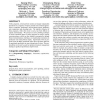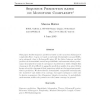279 search results - page 6 / 56 » On Sequence Prediction for Arbitrary Measures |
BMCBI
2008
13 years 7 months ago
2008
Background: As a rule, peptides are more flexible and unstructured than proteins with their substantial stabilizing hydrophobic cores. Nevertheless, a few stably folding peptides ...
EXPCS
2007
13 years 11 months ago
2007
Utility programs, which perform similar and largely independent operations on a sequence of inputs, include such common applications as compilers, interpreters, and document parse...
BIBM
2008
IEEE
14 years 2 months ago
2008
IEEE
Identifying functionally important sites from biological sequences, formulated as a biological sequence labeling problem, has broad applications ranging from rational drug design ...
COLT
2003
Springer
14 years 23 days ago
2003
Springer
This paper studies sequence prediction based on the monotone Kolmogorov complexity Km=−log m, i.e. based on universal deterministic/one-part MDL. m is extremely close to Solomon...
BIBM
2010
IEEE
13 years 5 months ago
2010
IEEE
The emergence of data rich domains has led to an exponential growth in the size and number of data repositories, offering exciting opportunities to learn from the data using machin...


